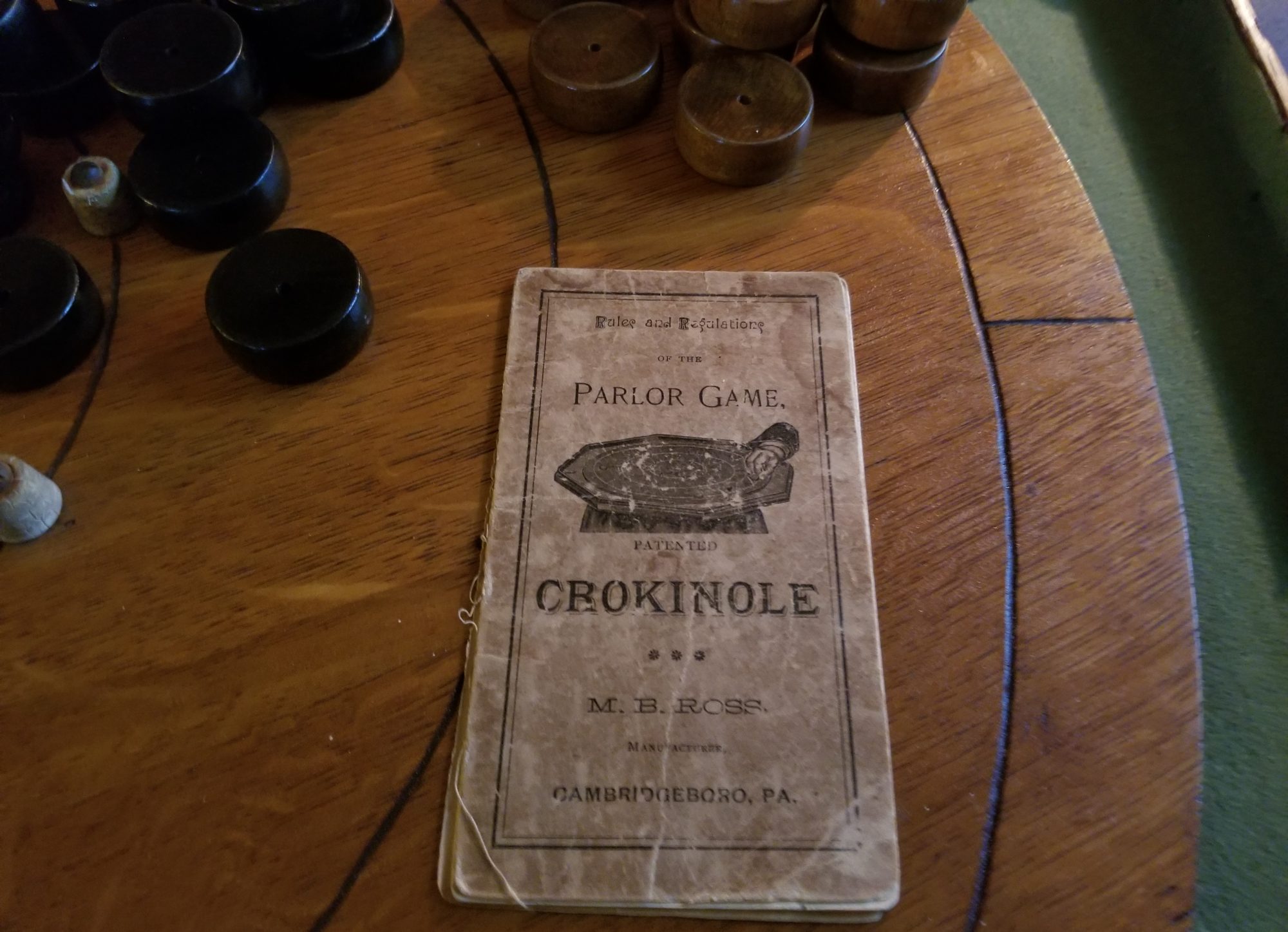
If you look at a current Carrom Game Board, you notice that it has more ink than your favorite pop star. It’s adorned with triangular points, fleur de lis style designs, checkered blocks, numbers and circles. But unlike many stars, it’s had some staying power; debuting in the 1890’s.
Even though the board is marked with so many options, I’m like most people who play these games and stick with the more mainstream choices. I’m obviously partial to crokinole and always curious how the game plays on various boards from the past. But, while examining a new item I bought, (a complete circa 1900 Star Archarena box of game pieces including spinners, a bowling back board and rules), I noticed a game and curious disclaimer that caught my eye. First though, a little history,
The original patent for crokinole expired in 1897 in the US which led to the overnight growth of several businesses trying to tap into the burgeoning family/parlor game industry. M.B. Ross, the owner of the expired patent, spent years fostering the growth of crokinole throughout the US and was quite successful. Now competition wanted a cut, and, while somewhat ‘wildcat’ in nature, were looking to ‘improve’ boards to protect their creations and profits by justifying a patent. This included the Ludington Novelty Works (later known as the Carrom Company), Leonard Manufacturing Company, South Bend Toy Company, Edw. Mikkelsen & Co. and the Archarena Game Company, among others. This last company will merge with Carrom in 1901 and is the manufacturer of my box of game pieces.
The companies started with modest additions to crokinole. For example, the Ludington Novelty Works combined it with its main offering, carrom , and other back-side games like chess and checkers. Soon companies added items like backgammon, and a slew of disk, top, and pin related games. While many of these games only had slight variations, it allowed manufactures to tout their boards over the paltry offerings of their competitors.
It was with this in mind that I looked at the bowling offerings on the Star Archarena backing. This was included with the game to stop the pins from continuously flying off the board and noisily hitting the floor and probably eliminating, especially for parents, the same effect a leaking faucet has on the psyche. It was pretty ingenious to fix an issue while maximizing the real estate for ads and rules. It does confuse you a bit when you first see it, wondering why they would make what looks like the cover of a book without pages just to slap ads and rules on it.

Not sure why I started to review the bowling rules, except that I have always loved the sport. The dead wood title caught my eye since it is a common term heard when you play duckpin bowling in Baltimore. The second thing that grabbed my attention was the bowling game of Cocked Hat. It sounded like an interesting phrase but reading further, the sentence referencing that the St. Louis rules, under the auspices of that city’s “Cocked Hat League governs this game,” really piqued my interest. Wow, what authority the St. Louis, MO.Cocked Hat League swayed , even over game companies. As if there was a doubt, that a board player might question these rules; perhaps if they were provided by more suspect leagues like Cleveland’s CHL or the Greater Boise Chapter of Cocked Hatters (I made these up). Regardless, it just sounds so official.

Cocked Hat is a real life derivation of bowling and not just a board game. It uses only three pins (1, 7 and 10), forming the points of the triangle of a normal ten pin formation. You use a duckpin ball (much smaller than a normal ball and no holes) and you get three rolls just like in duckpin. A perfect game is 90. I’m guessing these were the details that made this the St. Louis version of Cocked Hat.
Amazingly, there is only one known place that has lanes and hosts Cocked Hat Bowling in the US. It is in St. Charles, Missouri which is outside of St. Louis, at the Corner Bar, an establishment hosting two lanes since 1875. Why Cocked Hat? The name derives from the the way that men fashioned their hats when playing. Fascinating since bowling games usually get their names based on pin style like candlepin or duckpin.

As I wrap up here, I have been asking myself why did I write this (my wife asked the same)? There are a few reasons. I am always amazed and grateful when a piece of history, especially Americana, is still holding on somewhere you least expect it. Sometimes it’s found in a phrase on the back of a game accessory written 120 years ago that leads you down a rabbit hole, or in this case a trap door. It’s the fun of sharing this with others (even with my not so reticent wife). It’s stumbling on other people’s passion projects while pursuing yours, like Kevin Hong’s visual documentation of bowling alleys all across North America. He so graciously let me use his photo of the lanes. Check out www.vintagebowling.net for an array of alleys. It’s knowing that there are other discoveries lurking, so cock your hats, explore and share.
